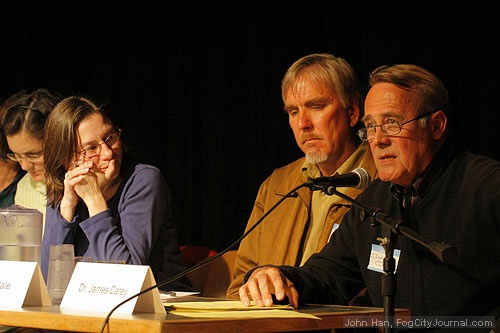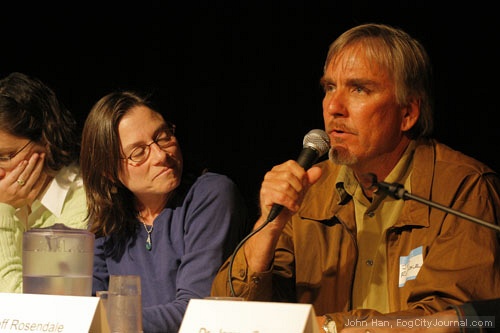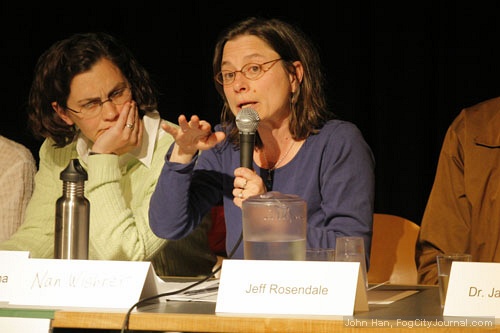
A panel of experts including Nan Wishner, Jeff Rosendale, and Dr. James Carey
spoke at a San Francisco town hall meeting yesterday to discuss State plans
to use chemical spray to eradicate Light Brown Apple Moth.
Photos by John Han
By John Han
April 25, 2008
Eradication of the light brown apple moth won’t work. That’s according to a panel of experts who spoke at a San Francisco town hall meeting last night over concerns about Light Brown Apple Moth (LBAM) spraying.
“Pheromone has never been used in any other eradication program,” said James Carey, Professor of Entomology at U.C. Davis. “Entomologists know that it is simply not a tool that can be used in eradication because it’s ineffective even as a control tool.”
“There aren’t exceptions. This program is an experiment,” Carey added.
Carey, who spent seven years on a panel with the California Department of Food and Agriculture (CDFA), says he’s seen how things work on the inside, and on the outside.
The USDA, according to Carey, has placed LBAM on the Class-A list because of its alleged ability to cause damage to California agriculture.
“There’s no science in that,” Carey said. “All science is cherry-picked and brought in to support the decision rather than the decision being based on science.”
Carey said his colleagues are reluctant to publicly state LBAM hasn’t damaged crops, “because of funding through agriculture.”
According to scientists, LBAM belongs to a family of “leaf roller” moths. Jeff Rosendale, a horticulturist and Executive Director of U.C. Santa Cruz Arboretum, said LBAM, unlike other species such as fruit fly, feed on tree leaves, not fruit.
“The reason it [LBAM] has significance is because they’re quarantined – they’re a pest in quarantine,” Rosendale said. LBAM has been given the “status of a pit-bull,” he said, but in reality it is “a Chihuahua.”

Jeff Rosendale
That “paper status,” Rosendale says, has caused agriculturists and horticulturists to meet stringent USDA zero tolerance standards for LBAM.
“That’s what’s happening to us right now. We’re in the zero tolerance directive,” Rosendale said.
That won’t change, according to Rosendale, until the USDA changes LBAM classification from Class-A to Class-B, the class other North American leaf roller moths fall into. Class-B moths have never been quarantined, according to Rosendale.
But putting pressure on the USDA to change the classification could take up to four to five years, according to experts.
Aerial spraying over San Francisco and other Bay Area cities to eradicate the moth is expected to begin in August despite a court decision yesterday to postpone spraying over Santa Cruz and Monterey.
Last year’s spraying in Monterey and Santa Cruz triggered an outcry of opposition from residents because the public has been kept uncertain as to what chemicals are being used.
Suterra LLC, the Oregon based company that manufactures the chemicals used in the LBAM spray, leaves over 82 percent of the ingredients unnamed, listing them as “other ingredients.”
Approximately 18 percent of the remaining ingredients include synthetic pheromones designed to disrupt the mating cycles of LBAM.
Following the aerial spraying in Santa Cruz and Monterey, over 600 cases of illness were reported.
In a recent report released by the Office of Environmental Health Hazard Assessment (OEHHA), the Department of Pesticide Regulations (DPR), and the California Department of Public Health (CDPH), the “other” ingredients, or “inert ingredients,” as they’re called, were disclosed, but not before having been kept from the public for months following the spraying.
At least three of the nine inert ingredients that are listed in the report are characterized as lung, skin, and eye irritants, according to material safety data sheets. Included is Butylated Hydroxytoluene (BHT), a known carcinogen.
According to Nan Wishner, Chair of the Albany Integrated Pest Management Task Force, BHT is a known carcinogen and mutagen that causes cell mutations. According to Wishner, BHT is also known to be associated with birth defects and miscarriages.

Nan Wisner
The report released by the State of Californa, however, does not indicate the percentages of inert ingredients used, citing patent protection.
OEHHA, DPR, and CDPH claim there is not enough evidence to determine if the health complaints in Monterey and Santa Cruz can be linked to LBAM spraying.
According to the Environmental Protection Agency (EPA), the inert ingredients used in the LBAM spray are safe. The government agency approved all of the ingredients in the spray – active or inert – “based on their low toxicity.”
An EPA analysis report, however, approves the ingredients in the pheromone spray for “products that come in contact with food,” but does not mention safety with respect to people, pets and wildlife.



 The Hunger Site
The Hunger Site
May 2, 2008 at 11:26 am
Dr. Colleen Panina – got it, thanks.
May 1, 2008 at 5:29 pm
Does anyone know the name of the pediatrician that spoke on the panel last Thursday? Colleen… something? (pictured on the far right next to Nan, above)